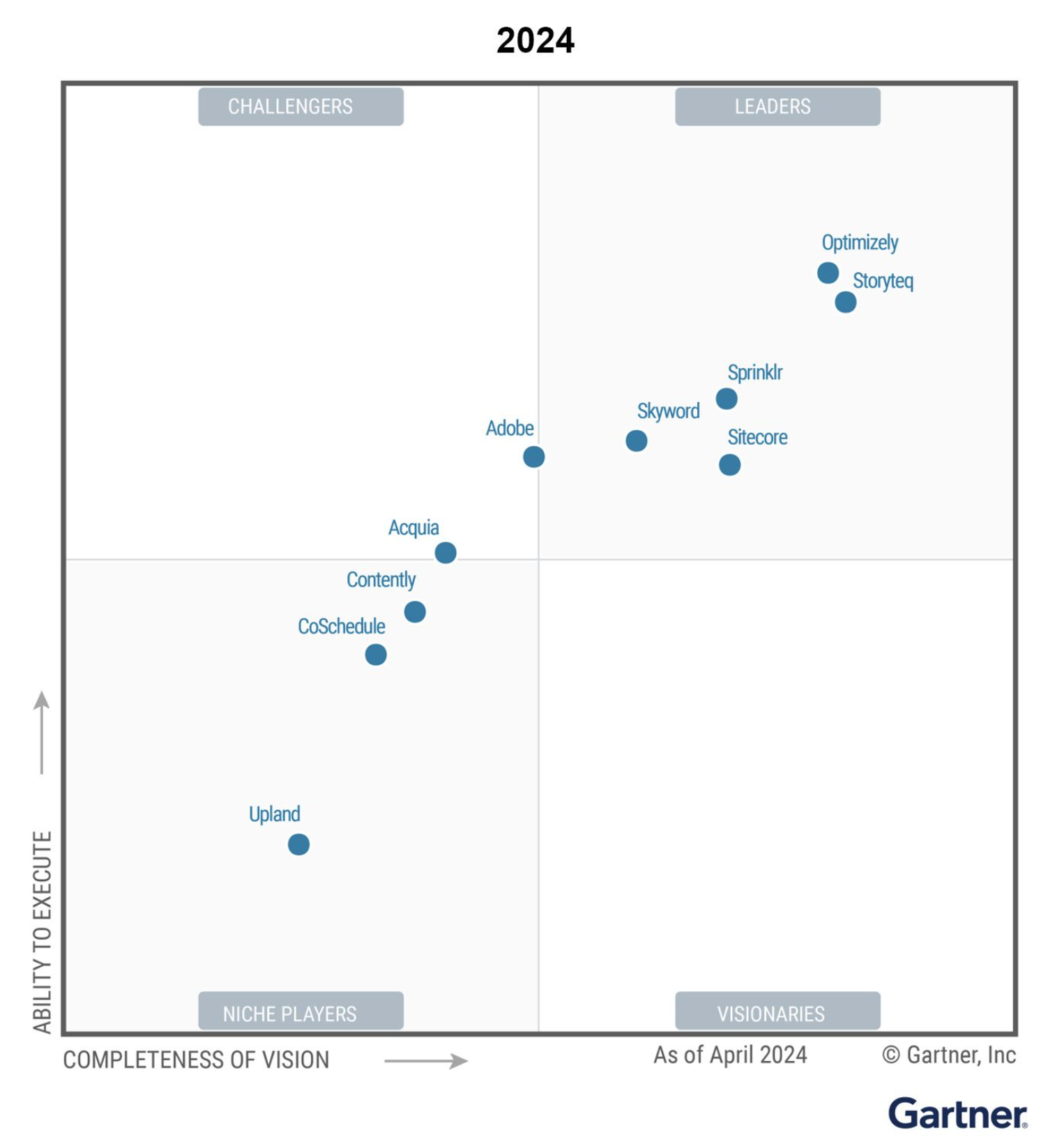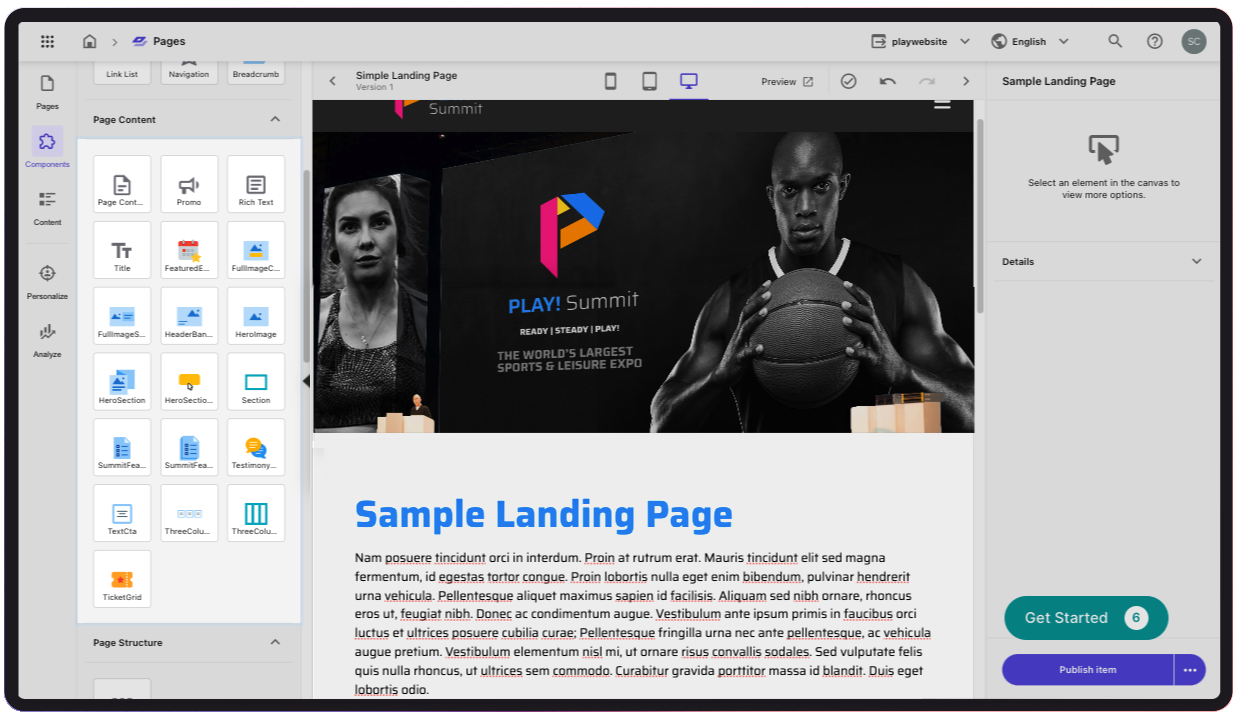Sonic Boom: Sitecore Surges Past $500M in ARR. Here’s Why It Matters

The CMS industry pioneer is facing an evolving market of choices. But once again, it has reinforced its position at the forefront of digital experience transformation and innovation – reflected by strong demand for its composable DXP.
The coolest thing about a sonic boom is that you can feel it.
I kid you not.
As the bird flies, I live less than 60 miles from Cape Canaveral, home of Kennedy Space Center – the most active spaceport on the planet. Rockets launch almost daily and can be viewed with the naked eye. Even at this distance, the flight of a Falcon 9 is audible.
But it’s not just the thunderous sound rippling through the atmosphere. At the right proximity, a sonic boom injects a heart-pounding thump in your ears, breaking through an invisible wall as an object moves faster than the speed of sound. It’s breathtaking.
Last week, Sitecore fired a similar shot toward the sky, jet-setting to a new orbit of performance. The digital experience software provider announced it had surpassed $500 million in annual recurring revenue (ARR) for fiscal ’24, attributing the growth to strong demand for its composable digital experience platform (DXP).
The key word here is composable, something Sitecore and its legacy rivals (sometimes referred to as “monoliths,” but that’s mired in mythological anachronism), have struggled with. As enterprises sought a more decoupled posture with their technology stacks, large DXPs were increasingly viewed through a Palaeolithic lens with rigid, locked-in licensing and expensive terms.
As MACH architectures exploded in popularity, Sitecore and its peers – still very much the market leaders – made a conscious effort to embrace more composable, cloud-based positioning around their products. This was validated by the analysts but, more importantly, by customers seeking the right blend of reliable enterprise solutions infused with composable structures.
Now, as we see headless CMSes and traditional DXPs arrive at a more balanced blend of attributes, each offering what the other has in a more “universal” manner (thanks Preston So), the differentiated value of platforms is being more clearly established – at least in some cases.
At the same time, I’ve spoken to many digital agencies and enterprises seeking reliable ecosystems that offer greater speed, extensibility, and support – as well as the enterprise-grade tools that are becoming more essential to delivering trusted commerce, healthcare, and public sector experiences that meet the evolving regulatory landscape.
There’s one other thing helping to fuel Sitecore’s growth, and that’s enterprise marketing teams – that scrappy cohort of creators left out in the cold as headless reared its head across the developer community. By reinforcing its commitment to improve the marketer's toolset and their collaborative agility, Sitecore is finding fertile ground to seed faster growth.
Lots of companies reach similar revenue benchmarks, and it’s not necessarily news. But in CMS country, Sitecore is foundational – legendary, even. Its omnipresence is a testament to its continued pursuit of what’s next, maneuvering every trend since coming to life in 2001. And of course, facing its detractors along the way.
There have been bumps in the road, and not just from a composable transformation perspective. A rumored sale by its PE parent dragged uncertainty into the equation, and there have always been challenges relative to cost, terms, and an inherent dependency on Sitecore-approved channel partners for support.
But set that aside, because the sonic boom you just heard (maybe even felt) suggests that Sitecore has found a composable launchpad for its future. As it charts the course ahead, it continues to listen and absorb the signals from its customers – and that’s making all the difference.
Marketers: the engine for velocity
In this hyperbolic digital economy, marketers need easier ways to control their global content lifecycle from strategy to delivery. To build connected customer experiences faster with data and AI, and deliver experiences across digital platforms that differentiate their offerings. This is manifesting in more user-friendly tools like visual editors and builders but also the rise of SaaS solutions that reduce the complexity of hosting and deploying.
Brands are being made or broken by the effectiveness of their marketing arms. And this isn’t just reflected in Sitecore’s defining attributes as a CMS or a DXP. In fact, the company has cemented its position as a Leader on Gartner’s MQ for Content Marketing Platforms (CMPs) – a category of enterprise-grade products that deliver high-quality content at scale to help brands tell big, interconnected stories that engage with customers and audiences.
Earlier this year, I did a deep dive around Gartner’s 2024 CMP grid. And while Optimizely is ruling the roost, Sitecore is gaining ground – and still well ahead of other DXP players like Acquia. Analysts are just one measure of performance, but it's clear that this entire field is continuing to build momentum and deliver strategic value.

The 2024 Gartner Magic Quadrant for Content Marketing Platforms
The focus on marketers also mirrors Sitecore’s investment in customer intimacy, a strategy that’s clearly paying off under its new CEO, Dave O’Flanagan. If you didn't catch the news, we covered O'Flanagan's rise to the captain's chair, taking the reins from Steve Tzikakis in March.
A change in top-level leadership is always a throat-clearing moment for a company. It has the propensity to either enhance confidence or stir fear. But O'Flanagan came to the interim role with solid credentials, which quickly grew into permanence – due in no small part to his focus on customers and his previous leadership chops (he was Chief Executive at Boxever, an up-and-coming CDP that was acquired by Sitecore in 2021).
“Businesses compete based on digital experience, so empowering brands matters more than ever,” O’Flanagan said, speaking about the recent ARR news. “We've spent the last year working with customers to ensure our future aligns with theirs. In the coming year, you’ll see us double down on bringing together content and experience with AI to create measurable business impact and momentum for our customers.”
Driving growth with XM Cloud
Born in the Danish cradle of CMS, Sitecore’s pioneering roots in the content management system market cannot be denied. Building on that legacy of innovation, the company is now leading with its composable, fully SaaS DXP as the next wave of its market thrust.
What's included? Everything a marketer needs for building dynamic digital experiences: content operations, digital asset management, experience management, commerce, data-driven personalization solutions, and more.
It’s worth noting that XM Cloud, the foundation for Sitecore’s DXP, has now become the fastest-growing solution in the company’s history – and for good reason. The product weaves together the best features of a modern SaaS CMS for building websites and digital experiences, and provides a host of next-gen capabilities.
Unlike its legacy Sitecore XP platform, XM Cloud offers an agile, cloud-native environment that eliminates many of the headaches associated with deployment and maintenance. Translation: no upgrades and high availability performance that enables creators to focus squarely on content.

Sitecore XM Cloud offers more flexibility to create, personalize, and publish content
What I like about XM Cloud is its sheer flexibility. The authoring experience is simple yet robust, giving users a highly intuitive UX for building and managing their experiences. It’s natively multisite, featuring a keen dashboard for handling all of your projects and assets in one place.
It would seem that every CMS has to sport a modicum of drag-and-drop capabilities (although point-and-click can still do the job), and some visual builders and editors are better than others. For its part, XM Cloud has a clean, fluid interface for composing pixel-perfect components with granular control, so it handles this well – and provides a great solution for making experiences like landing pages a snap.
Add in multilingual capabilities and real-time personalization and segmentation – all buoyed by clear analytics and optimization tools – and you have a tableau for creating effective, one-to-one content for every visitor. This makes XM Cloud a dynamite resource.
The built-in personalization and testing features are key, giving Sitecore’s customers a lever for iteratively improving their sites in response to shifting market dynamics. Personalization has long been a focus for Sitecore, but in an age of optimization, it has taken on a heightened level of importance in every stack.
Driving ultra-fast site speeds is also key to improving UX and conversions, and Sitecore’s ability to scale and centralize content management across sites, apps, and experiences is proving to be a game changer. According to Eric Stine, Sitecore's COO, speed is a key theme – not just for customers, but within the company's skunkworks.
“Sitecore has never taken its foot off the accelerator when it comes to innovation,” he said. “Our enduring focus on simplifying how marketers work, providing greater flexibility to developers, and producing meaningful, measurable business outcomes is growing demand for our solutions."
Amplifying with AI
Like its competitors (and, frankly, all software products), Sitecore is placing an outsized emphasis on artificial intelligence, which will clearly impact its XM Cloud strategy.
But this is just the latest development in a legacy of AI innovation. The company has long been investing in AI and machine learning's automation potential, including the development of its AI Auto Personalization and Cortex Processing Engine. In fact, the company won a 2020 Content Marketing Award with Microsoft for “Best Use of Content Involving AI.”
While it has been steadily investing in newer Generative AI as part of the content lifecycle and experience delivery, it has also made search a key part of its AI value proposition. It’s also worth noting that from a compliance perspective, the company has instituted a cross-functional AI Governance Board to oversee the ethical use of AI.
“I’m confident that Sitecore’s AI strategy, which is expanding the capabilities of our DXP portfolio, will further accelerate growth,” Stine commented.
Spoiler alert: Sitecore will demo its newest AI-driven innovations at Sitecore Symposium, October 15-18 in Nashville. I'll be covering the event in person, and sharing what I hear about Sitecore's AI plans (among other things).
By the way, if you're evaluating XM Cloud or other Sitecore products, you can always connect with our team for deeper insights that can enhance your decision-making strategy.
Delivering value across industries
From a market perspective, Sitecore is seeing adoption of its composable DXP solutions in manufacturing, financial services, travel and hospitality, technology, retail, and healthcare. All the big ones.
There’s a compelling reason for the broad appeal. Despite a softening of IT budgets, organizations are continuing to prioritize digital transformation – and more importantly, use it as a fulcrum for differentiating their products and services with highly contextualized customer experiences. To that end, Sitecore is presenting a surface for scalability in all directions.
Having been around the block – almost 25 years at this point – Sitecore has made its way into the stacks of many leading brands. Today, it powers digital experiences for more than 3,000 enterprises around the globe, including Aon, Bayer, Emirates NBD, Iron Mountain, L’Oréal, and United Airlines. A big part of the appeal across this horizontal landscape is Sitecore’s flexibility, which allows for tacit specialization that meets the unique needs of each customer’s business and technology requirements.
Like its peers, Sitecore boasts the ability to connect marketers and developers, delivering simplicity for content creators while giving coders what they need to customize. By providing a uniform ecosystem – shaped by decades of explicit industry experience – Sitecore has assembled an environment for teams to collaborate and innovate more efficiently, which might give it a real edge over its competitors.
As previously stated, Sitecore’s DXP is also built for the demands of the enterprise, powered by a composable roadmap. That means organizations can choose specific products and capabilities today and add more as their business requirements evolve. This translates into greater confidence around the investment and TCO of building on Sitecore and mitigates some of the legacy inhibitors of overbuying for specific needs.
Building on a proven partner ecosystem
Being a legacy platform has its pros and cons. As I mentioned earlier, there’s always that perception of being the “old guard” (just ask Google). Certainly, reaching the pinnacle of the market helps temper any inherent ageism, but the development of a loyal community and channel is a big factor when battling attitudes and reinforcing innovation.
From a strategy perspective, Sitecore is prioritizing the expansion of its channels. The company already has hundreds of solution, ISV, global alliance, and digital agency partners worldwide, and these vital relationships have served it well over the years – providing the guidance, expert implementation, and dedicated support that extend Sitecore’s market expertise and geographic reach.
Also supporting the current momentum is an active, growing practitioner and developer community of more than 20,000 individuals, with nearly 250 MVPs. This large, vibrant ecosystem allows customers to tap into a vast network of Sitecore experts for specialized knowledge, tips, and more through multiple online and offline forums and events.
Why it matters
Hearing a sonic boom – and feeling it – is a relatively rare event (present proximity to Cape Canaveral notwithstanding). And like a sonic boom, Sitecore’s breaking the half-billion barrier is a notable moment.
But there’s more to this news than just the revenue. In the vast lore of the CMS game, Sitecore has proven to be one of the most resilient players on the chessboard. Even as the Magic Quadrants and Waves have ebbed and flowed over the years, Sitecore has maintained its footing – sometimes being counted down, but never out. This speaks to its massive footprint and culture of innovation.
To be sure, the DXP has faced significant headwinds and growing competition. To meet those challenges, it embarked on several aggressive trajectories in 2021, from the simultaneous purchase of Boxever and Four51 – announced on the same day – to a $1.2 billion investment strategy. At the time, it was the largest-ever capital infusion in the martech space.
Those risks might have felt somewhat reactive. But as Sitecore has shifted to a more composable posture, it’s clear that having a more complete offering has fueled its product agility, enabling it to offer greater flexibility and choice. Those investments, it seems, are paying off.
Choice is key, but there’s also the matter of trust – and the fact is, large brands are looking to mature industry partners like Sitecore to achieve scale and compliance. While purely composable stacks (think MACH) present great opportunities, they require significant time and investment. They also lack the inherent accountability that comes with a proven market entity.
And that’s the rub: enterprises are wrestling with impossible demands. There’s legacy data spread across a multitude of systems, digital assets in a myriad of places, and more complexity than ever before. Getting to market faster is trumping everything, and having reliable solutions that are purpose-built and easily integrated can speed up the journey.
This is further codified by the rising demand for more complete content marketing platforms that simply get the job done. Sitecore’s value as both a content hub and a CMP reflects true value for marketing organizations to meet the rigors of growth in a hyper-competitive market, giving marketers a more complete platform to excel.
Churn is a challenge for every major platform, and Sitecore is no exception. As enterprises seek less rigid licensing models, the prospect of composable architectures provides a panacea. But churn isn’t always a bad thing. It can also be a moment to reconcile with a very basic question: Are these the right kinds of customers for what we offer?
As I mentioned, there’s also the specter of “overbuying” that has plagued monoliths. Example: customers would use a platform’s Web CMS but were, perhaps, ill-equipped to support personalization tools they were forced to pay for. In many cases, this is why they opted for the exit. But that’s changing – and as Sitecore continues to provide a more flexible, composable, SaaS-oriented solution set, customers will have greater control over their future roadmap.
Sonic booms are momentary. They fade quickly, and we’re left asking how much faster an object can go, or the next ceiling it can break. Will Sitecore be able to maintain its speed and altitude, particularly as competition increases both up and downstream?
Only time will tell. But in this moment, it certainly has the right leadership and momentum to keep cruising higher.
Boom.
Upcoming Events
Sitecore Symposium 2024
October 15-18, 2024 – Nashville, Tennessee
Standout digital experiences start here! Sitecore Symposium is the leading industry conference for digital professionals to learn about digital experience management, digital customer experience, and related marketing topics. Featuring 100+ sessions, 40+ top customer brands, and Sitecore's largest gathering of marketing leaders, technologists, and our partner ecosystem. Get your tickets today!

CMS Kickoff 2025
January 14-15, 2025 – Tampa Bay Area, Florida
Join us next January in the Tampa Bay area of Florida for the third annual CMS Kickoff – the industry's premier global event. Similar to a traditional kickoff, we reflect on recent trends and share stories from the frontlines. Additionally, we will delve into the current happenings and shed light on the future. Prepare for an unparalleled in-person CMS conference experience that will equip you to move things forward. This is an exclusive event – space is limited, so secure your tickets today.
